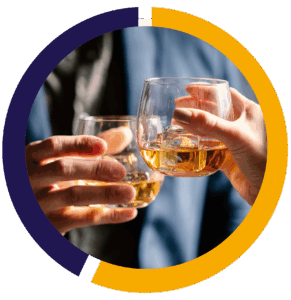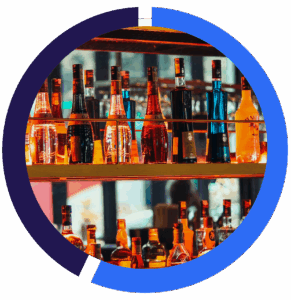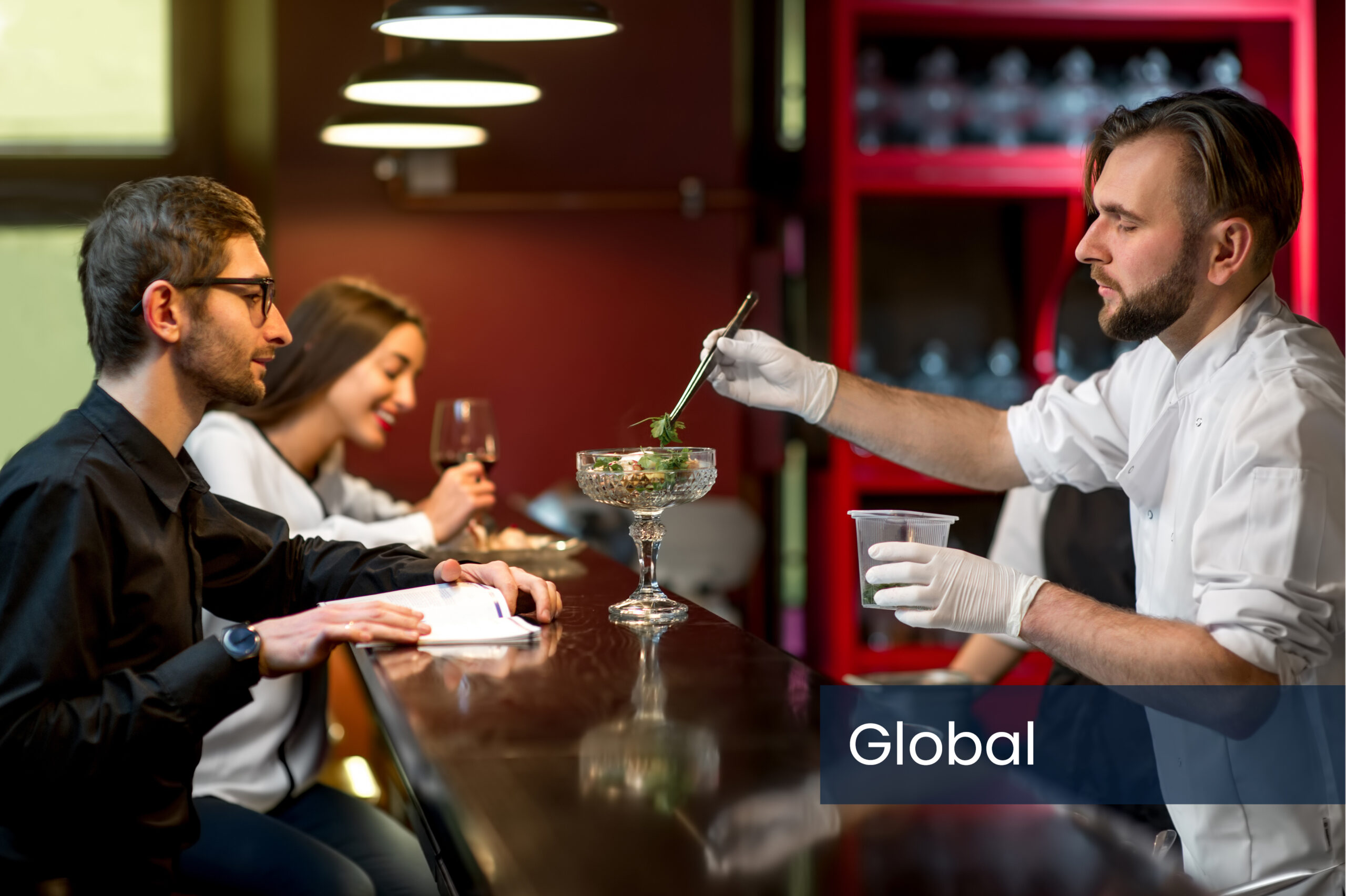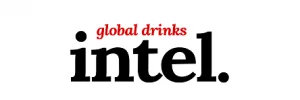
The world may be facing challenging times, with geopolitical tensions and rising inflation across numerous markets, yet the demand for premium experiences remains strong.
According to our latest Global REACH consumer survey, which provides insights into category, channel, occasion, and brand preferences in the On Premise, two in three global consumers favour high-quality drinks over cheaper alternatives. Even more notably, 55% are willing to pay extra for a better-quality drink. Financial pressures are certainly narrowing the trade-up opportunity, but premiumisation does remain a priority for many. In exploring the combinations of quality over quantity consumers prioritise in their drink purchases, it turns out the majority still favour either “a single super-premium drink” or “two high-quality drinks” rather than ordering a higher quantity of lower-quality options.
It must be said that, while the preference for a single super-premium drink has remained steady at 21% over the past year (indicating that those who can afford it continue to prioritize quality), the appeal of “two high-quality drinks” has declined slightly. This shift has favoured options that include more average or lower end serves, suggesting that the average consumer is becoming more cautious with their spending. Indeed, the share of consumers willing to pay extra for better-quality drinks dropped from 63% in 2022 to 55% last year, impacting sales volumes. In Britain, for instance, premium and super-premium spirits saw significant declines, with volumes down 13.2% and 14.9%, respectively, compared to the previous year.
 A closer look at demographic data, however, reveals ongoing opportunities in the premium segment. Millennials, in particular, have increased their trade-up to super-premium options. Brands can attract these consumers in various ways, such as offering appealing spirit-and-mixer serves, leveraging visual triggers or celebrity endorsements. Regional data highlight opportunities for premiumisation, too. In Europe, for instance, drinkers are bucking the global trend. While premium beverages consumers seem to be declining worldwide, they have risen by a notable 3 percentage points (pp) in Europe since 2022, now reaching 14% of all On Premise users. Businesses must closely track their habits if they want to offer them the right products at the right time and place. For example, our research indicates that drinkers are gradually starting their nights out earlier than they used to. When asked whether the time of the day they go out to drink has changed compared to last year, 19% of the average consumer reported going out earlier, compared to just 9% who are going out later. This shift is even more pronounced among premium consumers, with nearly one in four now going out earlier. This shift should be carefully considered, as changes in the timing of On Premise visits may influence how people perceive these occasions – which is not necessarily a challenge, but rather an opportunity to introduce innovative products tailored to these new time slots or new ways to enjoy existing brands.
A closer look at demographic data, however, reveals ongoing opportunities in the premium segment. Millennials, in particular, have increased their trade-up to super-premium options. Brands can attract these consumers in various ways, such as offering appealing spirit-and-mixer serves, leveraging visual triggers or celebrity endorsements. Regional data highlight opportunities for premiumisation, too. In Europe, for instance, drinkers are bucking the global trend. While premium beverages consumers seem to be declining worldwide, they have risen by a notable 3 percentage points (pp) in Europe since 2022, now reaching 14% of all On Premise users. Businesses must closely track their habits if they want to offer them the right products at the right time and place. For example, our research indicates that drinkers are gradually starting their nights out earlier than they used to. When asked whether the time of the day they go out to drink has changed compared to last year, 19% of the average consumer reported going out earlier, compared to just 9% who are going out later. This shift is even more pronounced among premium consumers, with nearly one in four now going out earlier. This shift should be carefully considered, as changes in the timing of On Premise visits may influence how people perceive these occasions – which is not necessarily a challenge, but rather an opportunity to introduce innovative products tailored to these new time slots or new ways to enjoy existing brands.
Businesses can also focus on the factors that influence premium drinkers’ brand or product choices. For example, one in three trust recommendations from friends and family, indicating that this segment values social connections and sharing experiences. A comparable percentage pays attention to menus, meaning they are keen to be personally involved in the decision-making process. A further crucial element is that one in four premium drinkers seek recommendations from bartenders: they trust drinks professionals and interact with them as a central part of their going out experience. Our research shows that around four in five bartenders regularly make drink recommendations to guests: businesses must recognise the key role of servers and view them as true ambassadors for their brands. They should get bartenders genuinely excited about the brand; when bartenders are passionate about a product, they are more likely to promote it enthusiastically to their guests, creating an authentic connection and enhancing the overall experience for people. Our research confirms that waiting staff know they must prioritise guest preferences when suggesting drinks, but it also shows that they want to promote brands they personally enjoy. 42% say they proactively recommend their own favourite brands, while 39% focus on high quality as a key criterion when making recommendations to guests.
Going premium in Asian markets
 With gradual societal shifts worldwide and a more challenging trade landscape in the West, Asian markets are becoming increasingly attractive to drinks brands, especially premium ones. When targeting these countries, drinks businesses should carefully assess which On Premise channels consumers prefer for high-end drinking experiences. In Singapore, for example, the strongest demand for premium-plus drinking is in wet-led venues, yet suppliers must also establish a strong presence in food-led venues, perhaps by developing a “with-food” consumption strategy to fit in with the occasion. Meanwhile, in Malaysia, premium drinking dominates in wet-led venues, while late-night bars and nightclubs are the preferred premium venues in Japan. In Indonesia, a well-established higher-end consumer base spans all On Premise channels, presenting an opportunity for premium brands to drive higher-value sales across various venue types.
With gradual societal shifts worldwide and a more challenging trade landscape in the West, Asian markets are becoming increasingly attractive to drinks brands, especially premium ones. When targeting these countries, drinks businesses should carefully assess which On Premise channels consumers prefer for high-end drinking experiences. In Singapore, for example, the strongest demand for premium-plus drinking is in wet-led venues, yet suppliers must also establish a strong presence in food-led venues, perhaps by developing a “with-food” consumption strategy to fit in with the occasion. Meanwhile, in Malaysia, premium drinking dominates in wet-led venues, while late-night bars and nightclubs are the preferred premium venues in Japan. In Indonesia, a well-established higher-end consumer base spans all On Premise channels, presenting an opportunity for premium brands to drive higher-value sales across various venue types.
Targeting the right venues alone is, however, not enough to win over consumers looking to trade up. This data must be cross-referenced with category-specific insights to identify and offer the drinks with the strongest appeal to premium drinkers. Beer is by far the most popular alcoholic beverage among the average consumer in Japan, but when it comes to premium experiences, sparkling wine and whisky are the key categories that brands, operators, and suppliers should focus on. In fact, consumers of the latter are more likely to prioritise quality over quantity and are willing to spend more for it. Around 55% of whisky drinkers would prefer one luxury drink or two high-quality premium drinks over any other option if given the choice. In Thailand, whisky is not only the most popular spirit overall, but it also holds a prominent position in premium spaces, especially in high-end bars. With 91% of Thai drinkers likely or very likely to pay extra for a better-quality drink, the potential for growth in this market is clear. Thailand has long been an attractive market for the drinks industry, and with recent news suggesting that the country may soon relax some regulations on alcohol sales and advertising, the opportunities for higher-end brands look even more promising. Similarly, in Malaysia, whisky is the most consumed spirits category, chosen by 38% of On Premise users. Once again, these consumers are likely to trade up, with 59% of them willing to spend more for a higher-quality drink.
 When it comes to white spirits, gin is the most promising category for brands, suppliers, and operators looking to tap into the Malaysian market. It might well be only the fifth most popular spirit, but over half of its drinkers are inclined to trade up. Also, gin drinkers in Malaysia are more loyal than whisky lovers, making the opportunity in this category particularly compelling. Gin is even more popular in Singapore, where 37% of its drinkers are eager to trade up, and in Indonesia, where drinkers enjoy the spirit across various channels and occasions, leaving room for plenty of trade-up opportunities. These people are seeking innovative, unique, and exclusive drinks, so fostering innovation – whether through serve presentations, experiences, or other brand associations – is key to driving premiumisation.
When it comes to white spirits, gin is the most promising category for brands, suppliers, and operators looking to tap into the Malaysian market. It might well be only the fifth most popular spirit, but over half of its drinkers are inclined to trade up. Also, gin drinkers in Malaysia are more loyal than whisky lovers, making the opportunity in this category particularly compelling. Gin is even more popular in Singapore, where 37% of its drinkers are eager to trade up, and in Indonesia, where drinkers enjoy the spirit across various channels and occasions, leaving room for plenty of trade-up opportunities. These people are seeking innovative, unique, and exclusive drinks, so fostering innovation – whether through serve presentations, experiences, or other brand associations – is key to driving premiumisation.
Focusing on cocktails can be a winning strategy in Indonesia, too, especially if businesses personalise the experience for drinkers through the likes of customised garnishes, unique glassware, or other elements that enhance the visual appeal and elevate the overall drinking experience. In Thailand, an impressive 30% of consumers drink cocktails, and among them, 70% consume cocktails nearly every time they go out. What’s more, the vast majority of these (74%) already opt for luxury or premium serves, which presents a substantial opportunity for high-end brands. The situation is similar in Malaysia, where there is a strong demand for premium-plus cocktails, which brands, suppliers, and operators can meet by offering innovative and appealing high-quality serves.
In Asia as in Europe, there are plenty of consumers still eager to trade up. Drinks businesses just need to carefully assess who these On Premise users are, the channels they favour and frequent, the multiple reasons behind their trade-up choices, and the categories they are most likely to invest in. By understanding these factors, brands, suppliers, and operators can tailor their strategies to better align with consumer preferences, ensuring they capture this demand and maximise profits from the ongoing premiumisation trend in the months ahead.
CGA’s OPUS and REACH surveys offer a comprehensive suite of tools for On Premise businesses to make informed decisions and drive success. The former provides insights into category, channel, occasion, and brand questions, aiding in sales and marketing strategy optimisation in various On Premise markets. Simultaneously, REACH illuminates eating and drinking behaviours, offering valuable in-market insights and benchmarking for targeted consumer outreach. To learn more about CGA’s capabilities across the global On Premise market, visit www.cgastrategy.com and email Jonny Jones, Managing Director International Markets at Jonathan.Jones@nielseniq.com
Originally published in Global Drinks Intel Magazine




